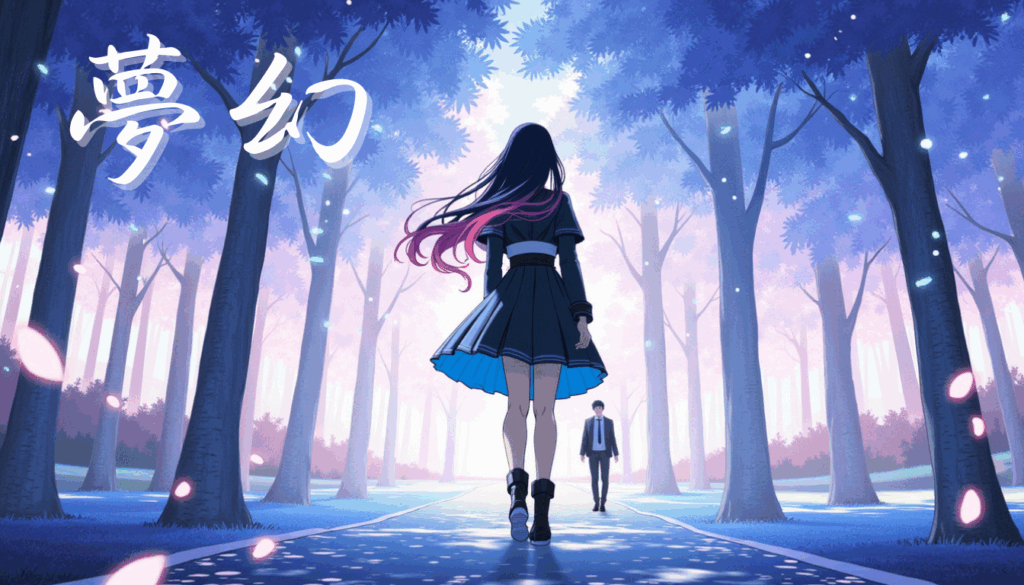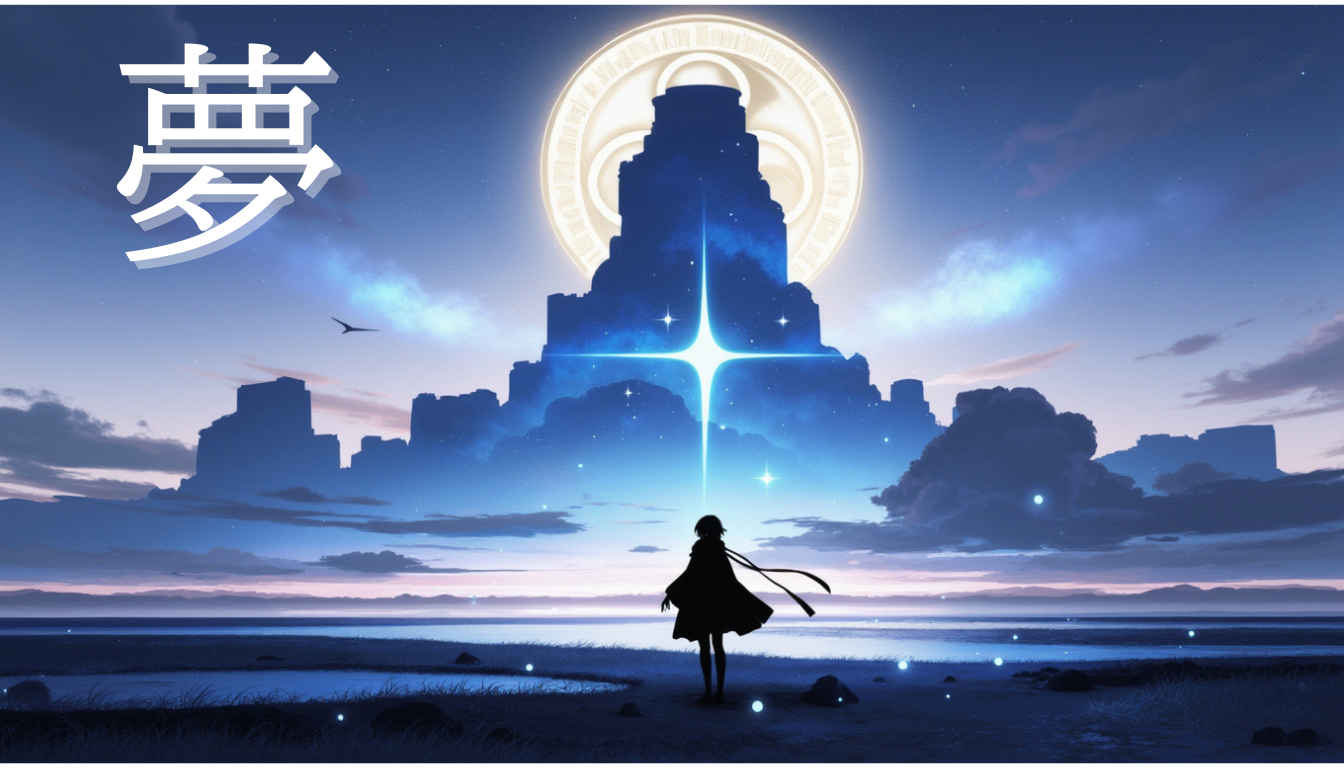Have you ever been fascinated by the word “dream” in Japanese?
In Japanese, the character 夢 (yume) doesn’t just mean “dream” — it carries deep layers of meaning, from hopes and goals to illusions and fleeting beauty. As someone who grew up surrounded by this language, I’ve always found kanji to be more than letters — they’re little windows into the soul of Japanese culture.
In this article, I’ll guide you through 7 beautiful Japanese kanji expressions that use 夢, with easy explanations, cultural background, and even tattoo or creative use ideas. Whether you’re learning Japanese, exploring kanji for personal inspiration, or just love the aesthetic, there’s something here for you.
Let’s discover which “dream” kanji speaks to your heart.
What is the meaning of “yume” (夢) in Japanese? — From Yuna, who grew up with this word
When I was a child, I thought yume just meant the weird dreams I had while sleeping.
Flying in the sky, falling forever, talking to cats — you know, the usual.
But as I grew up in Japan, I noticed something more.
Yume appears in conversations not only about sleep, but also about hopes, goals, and even feelings we can’t quite hold onto.
We say “yume o ou” when someone is chasing their dream.
We say “yume ga hakanai” when a dream fades away too soon.
The kanji 夢 isn’t just a pretty symbol.
It carries something deeply Japanese — a sense of beauty mixed with impermanence.
And once you notice that, the word yume will feel less like a translation of “dream”… and more like a quiet, emotional truth.
7 Beautiful Kanji Expressions Using 夢 (Yume)
These are not just words — they’re fragments of feeling, culture, and quiet imagination.
1. 夢中 (muchuu) — To be lost in a dream
Literal meaning: In a dream / absorbed like dreaming
Common use: Deep focus, obsession, love
Pronunciation: mu-chuu (むちゅう)
When someone is so into something that they forget time, we say they’re in 夢中.
It could be a person, a hobby, a passion — anything that makes you forget to check your phone.
As a kid, I was in 夢中 drawing anime characters for hours without blinking.
And honestly? I still am.
This word is positive, simple, and often used in everyday Japanese.
If you’ve ever fallen in love with something — even for a moment — you’ve been in 夢中.
2. 夢幻 (mugen) — Dream and illusion
Literal meaning: A dream that’s an illusion
Common use: Fantasy, art, Buddhist texts
Pronunciation: mu-gen (むげん)
To me, 夢幻 feels like a misty dream you walk through with your heart open.
It’s beautiful, but you can’t hold it.
In Buddhism, this word expresses the idea that life itself is fleeting and unreal — like a dream or shadow.
It’s also popular in anime, music, and tattoo designs for its deep and mysterious vibe.
If you love fantasy or poetic words with a soft sadness, 夢幻 is a perfect choice.
3. 夢想 (musou) — Imagination or vision
Literal meaning: Dream-thinking / daydreaming
Common use: Creative thinking, ambition
Pronunciation: mu-sou (むそう)
夢想 is the dream you build when you’re awake — the one you want to make real.
It’s what writers, artists, and visionaries do when they close their eyes and imagine.
This kanji feels active, like the start of something new.
In Japan, it’s used to describe big ideas that haven’t been realized yet — but might be.
If you’re someone who dreams with your eyes open, 夢想 is your word.
4. 夢見 (yumemi) — Dream-seeing, gentle hope
Literal meaning: Seeing a dream
Common use: Poetic word for dreaming or hoping
Pronunciation: yu-me-mi (ゆめみ)
This word feels soft, almost whisper-like.
It’s used in old poetry and modern anime alike, often tied to romance or quiet longing.
You might hear it in phrases like “yumemi-gokochi” — a dreamy, floating feeling.
I love how 夢見 captures the idea of gentle hope, not just wild ambition.
It’s a perfect word if you’re someone who dreams quietly, but deeply.
5. 白日夢 (hakujitsumu) — Daydream
Literal meaning: White-day dream
Common use: Daydreaming, zoning out
Pronunciation: haku-jitsu-mu (はくじつむ)
This is the Japanese version of a daydream — when you space out and imagine something that may never happen.
In literature, 白日夢 sometimes carries a bittersweet vibe: hopes that never become real.
But it’s also playful, like when you imagine quitting your job and moving to a beach town (don’t we all?).
If you love imagining “what if” moments, 白日夢 is your kind of dream.
6. 夢物語 (yumemonogatari) — A story that’s just a dream
Literal meaning: Dream + Story
Common use: Unrealistic hopes or fantasy tales
Pronunciation: yu-me-mo-no-ga-ta-ri (ゆめものがたり)
This one has an old fairytale feel.
We use it to describe things that sound magical — but probably won’t come true.
Sometimes we say “Sore wa yumemonogatari da ne” — “That’s just a dream story,” when someone’s plan feels too unrealistic.
But still, there’s something romantic about chasing a dream so big it sounds like fiction.
That’s the charm of 夢物語.
7. 夢幻泡影 (mugenhouyou) — The dream-illusion-bubble-shadow
Literal meaning: Dream, illusion, bubble, shadow
Common use: Buddhist concept of impermanence
Pronunciation: mu-gen-hou-you (むげんほうよう)
This is the most complex phrase on the list — and one of the most beautiful.
In Buddhist thought, life is as fragile as a dream, an illusion, a bubble, and a shadow.
All temporary. All fading. All precious.
We don’t use this in everyday conversation, but you’ll find it in temples, calligraphy, or philosophical books.
If you’re drawn to deep meaning and quiet reflection, 夢幻泡影 is a word to sit with.

Which “dream” kanji is best for a tattoo or artwork?
If you’re considering using a Japanese kanji for a tattoo, design, or personal motto, choosing one with deep meaning and cultural respect is important. Here are some of the most suitable “dream” kanji expressions — and why they work so well visually and emotionally.
1. 夢 (yume) — The classic single-character choice
Simple. Beautiful. Instantly recognizable.
This kanji alone captures the idea of dreaming, hoping, and reaching.
Because of its balance and flowing stroke structure, 夢 looks elegant in brush-style fonts and minimalist tattoos.
It’s a popular choice — but never overused, because the feeling it holds is timeless.
2. 夢幻 (mugen) — Aesthetic and mysterious
Visually, this word has a strong presence: the sharpness of 幻 (illusion) next to the softness of 夢.
Emotionally, it speaks to those who feel drawn to ephemeral beauty and fantasy.
“Mugen” tattoos are especially popular among fans of anime, Japanese poetry, or Zen art.
Just be aware: its Buddhist tone can carry spiritual depth, so use it with awareness.
3. 夢想 (musou) — For the dreamers who build
If your dream is something you want to make real, not just admire — this is your kanji.
夢想 suggests vision, ambition, and creativity.
It’s a strong choice for artists, entrepreneurs, and creators who imagine something greater and act on it.
Design-wise, it looks sleek and bold when written vertically.
4. 夢見 (yumemi) — Soft, romantic, poetic
This one feels delicate and lyrical.
It’s perfect for those who want a word that reflects quiet hopes, soft love, or introspective beauty.
Great for calligraphy, minimalist wall art, or even name concepts (yes, it appears in manga character names too).
Tattoo Caution Box
Note: Always double-check kanji meanings with a native speaker or trusted source before getting a tattoo.
Some kanji may carry deeper religious or cultural weight, and it’s important to understand the nuance.
How to use these kanji in daily life or creative work
Learning the meaning of kanji is just the beginning — what makes them powerful is how you use them.
Here are some ways people (including me!) bring “dream” kanji into their lives and creative expressions.
1. For daily inspiration
Words like 夢中 (muchuu) or 夢想 (musou) are great for motivation.
You might write them on a sticky note, journal header, or your laptop background.
They remind you that you’re not just living — you’re chasing something meaningful.
2. For art, poetry, and calligraphy
Kanji like 夢幻 (mugen) or 夢見 (yumemi) feel poetic and are perfect for calligraphy or zine-style artworks.
Even just drawing the characters slowly can be a kind of meditation.
Try writing them with a brush pen — the process itself feels dreamy.
3. For creative naming
In Japan, creators sometimes use kanji like 夢物語 in book titles, video games, or anime characters.
It gives the work a layer of symbolic meaning, even for those who don’t read Japanese fluently.
You could use one of these kanji as a name for:
- Your artwork series
- Your online username
- A blog or small brand with emotional depth
4. For personal reflection
Even if you never show it to anyone, having a favorite kanji — one that speaks to your heart — can be grounding.
For me, it’s 夢見.
It reminds me that it’s okay to hope quietly, even when I can’t see where it’s going yet.
Kanji are not just characters.
They’re little mirrors, reflecting what we feel but sometimes can’t say in words.

More dream-related kanji and expressions to explore
If you’re someone who loves deeper meanings, Japanese offers many expressions that take the idea of “dream” even further — into poetry, philosophy, and ancient stories.
Here are a few that I find especially moving.
1. 一炊の夢 (issui no yume) — A dream during one rice cooking
This old expression comes from a Chinese legend.
A man dreams of a lifetime of glory — only to wake up before the rice he cooked was even ready.
It teaches us that even grand achievements can be fleeting.
In Japanese, it’s used to describe the impermanence of success, or the way life can feel like a dream when you look back.
2. 南柯一夢 (nanka no ichimu) — One dream beneath a southern tree
Another classic saying.
A man falls asleep under a tree and lives a whole other life in his dream — only to wake and find nothing was real.
To me, this expression is both beautiful and slightly haunting.
It reminds us that even the most vivid experiences may fade, just like dreams.
3. 夢幻泡影 (mugenhouyou) — Dream, illusion, bubble, shadow
We met this phrase earlier, but it’s worth repeating here.
It’s a Buddhist expression that says:
All things are as insubstantial as dreams, illusions, bubbles, and shadows.
It’s not meant to make you sad — it’s a reminder to cherish what’s here now.
Because it won’t last forever.
4. Bonus: Anime, music, and pop culture dreams
You’ll often see “dream” kanji in J-pop lyrics, anime titles, or manga themes.
From Yume no Naka e to Mugen Train, the idea of dreams is everywhere in Japanese pop culture.
That’s because dreams — both hopeful and fragile — are part of how we feel, grow, and imagine.
H2-7: Summary — Which dream kanji speaks to you?
Dreams are not just things we see when we sleep — they’re feelings, goals, illusions, and reflections of who we are.
Japanese kanji gives us so many ways to express that idea.
From the focused energy of 夢中, to the quiet beauty of 夢見, to the deep reflection of 夢幻泡影 — each one carries its own emotional tone.
You don’t have to use these words perfectly.
Just finding one that resonates with you is already a kind of connection.
So… which one speaks to your dream?


Comments